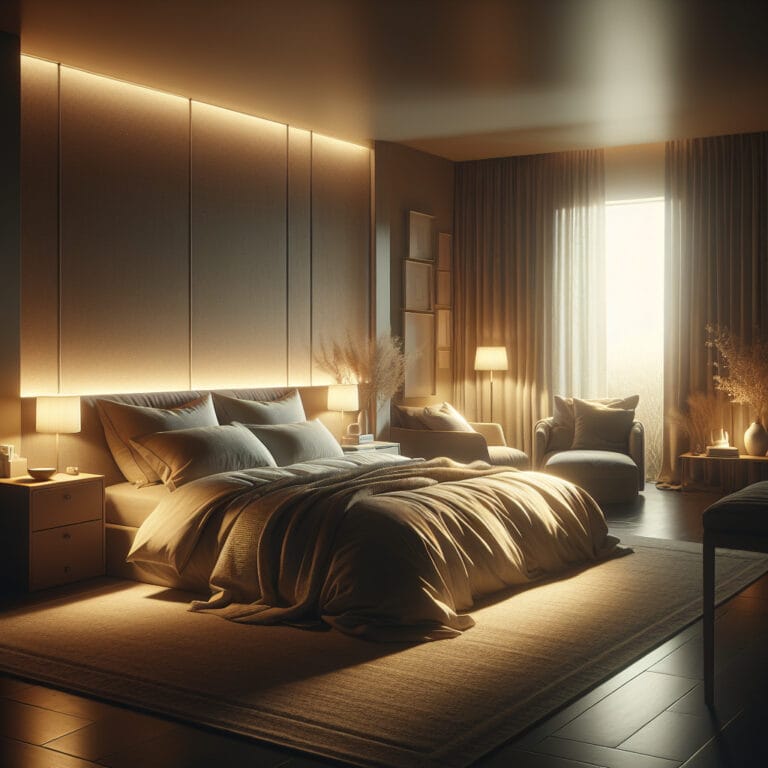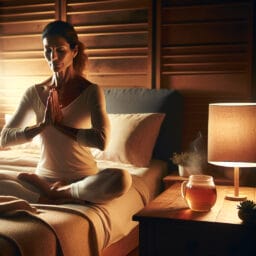
Unraveling the Secrets: Defining the Ideal Sleep Environment
Table of Contents
- Introduction
- Importance of a Good Sleep Environment
- Factors Influencing the Ideal Sleep Environment
- Tips to Create the Ideal Sleep Environment
- The Role of Sleep Environment in Sleep Quality
- Conclusion
- Frequently Asked Questions
Introduction
The importance of a good sleep environment can’t be overstated when it comes to maintaining healthy habits and behaviours around sleep. It’s essential for aligning our body clock, supporting nocturnal sleep, and promoting overall wellbeing. A tailored, ideal sleep environment can address individual differences in sleep needs and improve the quality of your rest. Consider this: poor sleep health can lead not only to daytime napping but also other more serious sleeping problems such as insomnia which may require CBT-I therapy.
Environmental factors play a significant role in shaping your sleep profile. For side-sleepers, neck pain pillows or memory foam mattress make the difference between a night of tossing and turning or deep slumber. Others might find that temperature adjustments are key; keeping the room around 60-67 degrees Fahrenheit is recommended by Sleep Health Foundation fact sheets.
Moreover, your bedtime routine also matters. Sleep hygiene education highlights avoiding late evening exercise or drinking caffeinated beverages close to bedtime since these activities excite rather than calm the body making it harder to fall asleep. Remember that while bed sharing may work for some people, having an undisturbed space dedicated solely for rest may be beneficial for others.
All in all, optimizing your sleep environment takes into account everything from bedding (like cooling sheets and bamboo sheets) to noise control (perhaps with an eye mask or earplugs). Indeed achieving a good night’s sleep requires careful attention to both physical surroundings and lifestyle habits.
Importance of a Good Sleep Environment
The significance of an apt sleep environment goes beyond the mere convenience of comfort. It’s a crucial component in fostering healthy habits and behaviours around sleep, often underestimated yet highly influential. Its role is paramount in syncing our body clock with circadian rhythms, bolstering nocturnal sleep, and enhancing overall wellbeing. An array of environmental factors can impact this, from your choice of bedding – be it a memory foam mattress for side-sleepers or cooling sheets for maintaining optimal body temperature to noise control achieved via earplugs or an eye mask.
A conducive sleep environment can drastically improve one’s sleep quality while mitigating common sleep problems such as insomnia that might otherwise necessitate CBT-I therapy. Alarmingly, adverse conditions may trigger poor sleep health leading to daytime napping and other disturbances that disrupt subsequent sleep cycles. Delving into individual differences reveals interesting insights; while some find solace sharing their bed with loved ones, others report improved rest when sleeping alone.
Furthermore, reinforcing good practices through regular exercise training during the day coupled with avoiding evening exercise and refraining from drinking caffeinated beverages close to bedtime significantly enhances your ability to fall asleep effortlessly as per Sleep Health Foundation fact sheets.
In essence, optimizing your sleeping arrangements by paying heed to individualised sleep hygiene recommendations not only fosters better slumber but also boosts overall health by reducing the likelihood of developing chronic disorders associated with lacklustre rest.
Factors Influencing the Ideal Sleep Environment
While many of us have experienced the bliss of sinking into a memory foam mattress or feeling our body relax as it settles into an adjustable bed, the elements that contribute to a healthy sleep environment go beyond just comfort. As per the Sleep Health Foundation fact sheet, factors like light, noise, temperature and even our bedding play crucial roles in ensuring a good night’s sleep. Irregular exposure to light can disrupt our body clock and circadian rhythms, leading to falling asleep at inappropriate times or experiencing daytime napping. Likewise, environmental noise can cause sleep disturbances and reduce overall sleep quality.
However, not all individuals are affected equally by these factors – this is where individual differences come into play. Some might be side-sleepers who find relief from neck pain pillows, while others may require cooling sheets to maintain an optimal body temperature for restful slumber. Similarly, while some people may easily drift off amidst soft background noise; others would require an eye mask and ear plugs for total sensory deprivation.
An intriguing aspect is how bad sleep habits are often reinforced unknowingly. Drinking caffeinated beverages close to bedtime or engaging in evening exercise could excite rather than calm your system; making it harder for you to fall asleep when you hit the sack on your hybrid mattress or cheap mattress alike.
In essence, identifying these influences in your sleeping environment enables you to make adjustments based on your unique needs – shaping healthier habits behaviours around sleep hygiene recommendations. It’s not merely about getting that coveted good night’s sleep; it’s also about steering clear from potential sleeping problems such as insomnia which may require more intensive interventions like CBT-I therapy or PSG-assessed sleep studies.
| Factor | Description | Individual Differences |
|---|---|---|
| Light | Irregular exposure to light can disrupt our body clock and circadian rhythms. | Some individuals may require an eye mask for total sensory deprivation. |
| Noise | Environmental noise can cause sleep disturbances and reduce overall sleep quality. | Some people may easily drift off amidst soft background noise while others may require ear plugs for total sensory deprivation. |
| Temperature | The temperature of the sleep environment can affect the quality of sleep. | Some individuals may require cooling sheets to maintain an optimal body temperature for restful slumber. |
| Bedding | The comfort of our bedding plays a crucial role in ensuring a good night’s sleep. | Side-sleepers may find relief from neck pain pillows, whereas others might prefer a memory foam mattress or an adjustable bed. |
| Bad Sleep Habits | Drinking caffeinated beverages close to bedtime or engaging in evening exercise could excite rather than calm your system. | Identifying these influences enables you to make adjustments based on your unique needs and shape healthier habits around sleep hygiene recommendations. |
Tips to Create the Ideal Sleep Environment
It’s fascinating to consider how something as simple as our bedroom setup can greatly influence our sleep patterns, and ultimately, our overall health. According to the Sleep Health Foundation fact sheet, creating an optimal sleep environment extends beyond having a comfortable bed; it’s about taking charge of all the factors that might impact your nocturnal slumber. Here are some practical tips to achieve a serene sleep setting: start by adjusting room temperature – aim for around 60-67 degrees Fahrenheit, which is considered ideal for invoking drowsiness and improving sleep quality. Blackout curtains can be a game-changer for light-sensitive individuals or city dwellers dealing with street lights; they help align your body clock with the natural circadian rhythms of darkness and light, preventing daytime napping due to irregular sleep timing. Carefully selecting your bedding also plays a significant role in enhancing healthy habits behaviours around rest – whether you’re side-sleeping on memory foam pillows or sinking into cooling sheets atop a hybrid mattress after an invigorating session of exercise training. And who could forget the soothing rhythm of white noise machines? They mask environmental noises and reduce chances of sudden disruptions in subsequent sleep patterns. Around bedtime, strive to avoid caffeinated drinks that stimulate wakefulness rather than promoting peaceful rest. Remember each individual’s needs differ – pay attention to cues from your body and adjust accordingly using these individualized sleep hygiene recommendations for better rest night after night.
| Tip | Explanation |
|---|---|
| Adjust room temperature | Target a temperature of around 60-67 degrees Fahrenheit, which is considered ideal for inducing drowsiness and improving sleep quality. |
| Use blackout curtains | Especially useful for light-sensitive individuals or city dwellers dealing with street lights. They help synchronize your body clock with the natural circadian rhythms of darkness and light, preventing daytime napping due to irregular sleep timing. |
| Select suitable bedding | Whether you’re side-sleeping on memory foam pillows or sinking into cooling sheets atop a hybrid mattress, choosing the right bedding can enhance healthy habits around rest. |
| Use white noise machines | White noise machines mask environmental noises and reduce the chances of sudden disruptions in sleep patterns. |
| Avoid caffeinated drinks near bedtime | Caffeinated drinks stimulate wakefulness rather than promoting peaceful rest, so they should be avoided close to bedtime. |
| Pay attention to individual needs | Each person’s needs are different, so it’s important to pay attention to cues from your own body and adjust accordingly using these individualized sleep hygiene recommendations for better rest night after night. |
The Role of Sleep Environment in Sleep Quality
The relationship between your sleep environment and the quality of your nocturnal sleep is incredibly intricate. A well-adjusted sleeping space, which adheres to individual sleep hygiene recommendations, can significantly alleviate common sleep disturbances and even more complex sleeping problems such as insomnia. Poorly conceived settings, on the other hand, may unintentionally reinforce bad sleep habits that drastically affect your body clock and circadian rhythms. Mattresses play a fundamental role in this aspect; whether it’s a memory foam mattress for side-sleepers or a cooling mattress atop an adjustable bed frame for those grappling with high body temperature during their slumber. And let’s not forget about bedding – pillows specifically designed to counter neck pain or sheets tailored to regulate body temperature can make all the difference in achieving that elusive good night’s sleep. Environmental factors too like room temperature maintained ideally around 60-67 degrees Fahrenheit have been scientifically proven by Sleep Health Foundation fact sheet to foster better rest by inducing drowsiness at appropriate timings. Lastly, do bear in mind that embracing these healthy habits behaviours also include limiting evening exercise close to bedtime and refraining from consuming caffeinated beverages which could potentially stimulate wakefulness rather than tranquillity.
Conclusion
Cultivating an optimal sleep environment isn’t merely a comfort indulgence, but rather a pivotal aspect in fortifying our overall wellness. Anchored by the Sleep Health Foundation fact sheet, an adept blend of environmental factors work harmoniously to boost our nocturnal sleep quality. This includes maintaining ideal room temperature around 60-67 degrees Fahrenheit, reducing ambient noise with earplugs or eye masks for sensory deprivation and selecting suitable bedding for individual needs – whether it’s neck pain pillows for side sleepers or cooling sheets atop hybrid mattresses. These measures not only mitigate common sleeping problems like insomnia and daytime napping – they embody individualized sleep hygiene recommendations which foster healthful habits such as appropriate exercise training schedules and limiting evening caffeine intake. Hence, investing time in refining your sleep environment is indeed a rewarding endeavour that reinforces healthier body clock function, improved circadian rhythms synchronization and ultimately, nurturing sounder slumber night after night.



